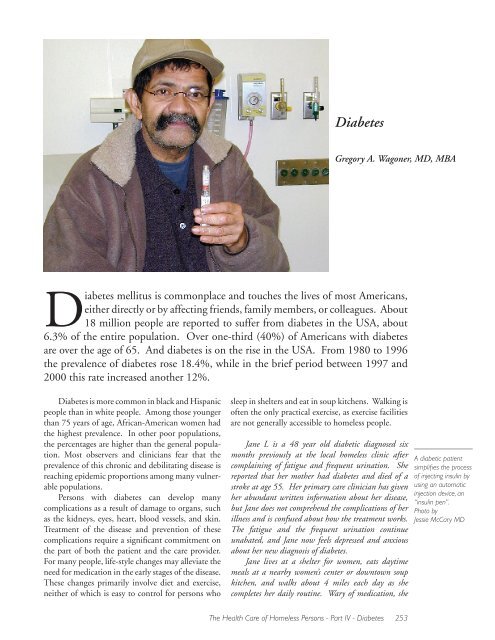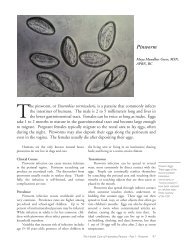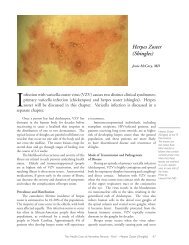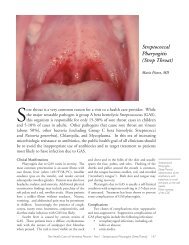Diabetes - Boston Health Care for the Homeless
Diabetes - Boston Health Care for the Homeless
Diabetes - Boston Health Care for the Homeless
Create successful ePaper yourself
Turn your PDF publications into a flip-book with our unique Google optimized e-Paper software.
<strong>Diabetes</strong>Gregory A. Wagoner, MD, MBA<strong>Diabetes</strong> mellitus is commonplace and touches <strong>the</strong> lives of most Americans,ei<strong>the</strong>r directly or by affecting friends, family members, or colleagues. About18 million people are reported to suffer from diabetes in <strong>the</strong> USA, about6.3% of <strong>the</strong> entire population. Over one-third (40%) of Americans with diabetesare over <strong>the</strong> age of 65. And diabetes is on <strong>the</strong> rise in <strong>the</strong> USA. From 1980 to 1996<strong>the</strong> prevalence of diabetes rose 18.4%, while in <strong>the</strong> brief period between 1997 and2000 this rate increased ano<strong>the</strong>r 12%.<strong>Diabetes</strong> is more common in black and Hispanicpeople than in white people. Among those youngerthan 75 years of age, African-American women had<strong>the</strong> highest prevalence. In o<strong>the</strong>r poor populations,<strong>the</strong> percentages are higher than <strong>the</strong> general population.Most observers and clinicians fear that <strong>the</strong>prevalence of this chronic and debilitating disease isreaching epidemic proportions among many vulnerablepopulations.Persons with diabetes can develop manycomplications as a result of damage to organs, suchas <strong>the</strong> kidneys, eyes, heart, blood vessels, and skin.Treatment of <strong>the</strong> disease and prevention of <strong>the</strong>secomplications require a significant commitment on<strong>the</strong> part of both <strong>the</strong> patient and <strong>the</strong> care provider.For many people, life-style changes may alleviate <strong>the</strong>need <strong>for</strong> medication in <strong>the</strong> early stages of <strong>the</strong> disease.These changes primarily involve diet and exercise,nei<strong>the</strong>r of which is easy to control <strong>for</strong> persons whosleep in shelters and eat in soup kitchens. Walking isoften <strong>the</strong> only practical exercise, as exercise facilitiesare not generally accessible to homeless people.Jane L is a 48 year old diabetic diagnosed sixmonths previously at <strong>the</strong> local homeless clinic aftercomplaining of fatigue and frequent urination. Shereported that her mo<strong>the</strong>r had diabetes and died of astroke at age 55. Her primary care clinician has givenher abundant written in<strong>for</strong>mation about her disease,but Jane does not comprehend <strong>the</strong> complications of herillness and is confused about how <strong>the</strong> treatment works.The fatigue and <strong>the</strong> frequent urination continueunabated, and Jane now feels depressed and anxiousabout her new diagnosis of diabetes.Jane lives at a shelter <strong>for</strong> women, eats daytimemeals at a nearby women’s center or downtown soupkitchen, and walks about 4 miles each day as shecompletes her daily routine. Wary of medication, sheA diabetic patientsimplifies <strong>the</strong> processof injecting insulin byusing an automaticinjection device, an“insulin pen”.Photo byJessie McCary MDThe <strong>Health</strong> <strong>Care</strong> of <strong>Homeless</strong> Persons - Part IV - <strong>Diabetes</strong> 253
manages to take pills <strong>for</strong> blood pressure and thyroidproblems. She has been told that she will need to starta new pill <strong>for</strong> her diabetes but may require insulin viaa needle if her blood sugars do not respond to <strong>the</strong> pillsor her changes in diet and activity. Despite good intentions,she has little control of her diet and must accept<strong>the</strong> meals offered. With <strong>the</strong> pressure of finding a bed <strong>for</strong><strong>the</strong> night and <strong>the</strong> next meal, finding <strong>the</strong> time and placeto exercise is virtually impossible.Her blood sugar and glycosylated hemoglobin(hemoglobin A1C) tests remain high, and after amonth her doctor prescribes two injections of insulindaily. Jane has no insurance and is unable to fill <strong>the</strong>prescription <strong>for</strong> insulin, syringes, and needles <strong>for</strong> severalweeks. She needs education and training in <strong>the</strong> useand administration of insulin, a place to refrigerate hermedication as well as a safe place to keep her needles,and assistance with monitoring her progress once shebegins <strong>the</strong> injections. All of <strong>the</strong>se present complexbarriers that need to be overcome during her dailysearch <strong>for</strong> housing, food, and safety.Suffice it to say, she will need to make <strong>the</strong> care andtreatment of her diabetes an integral part of her dailyneeds – a day already filled with so many survival issuesthat such a burden is extremely difficult to bear. Shecontinues to see her primary care clinician regularly butbecomes depressed by <strong>the</strong> number of appointments sheneeds to remember, including <strong>the</strong> eye doctor, <strong>the</strong> nutritionist,<strong>the</strong> podiatrist, and <strong>the</strong> dentist. Sometimes, in<strong>the</strong> midst of her poverty and homelessness, it simplydoesn’t feel worth <strong>the</strong> ef<strong>for</strong>t. She believes that she willprobably “get by” as long as she just keeps doing whatshe did be<strong>for</strong>e. Her sugars improve a little, but <strong>the</strong>fatigue and her depression are overwhelming and shejust wants to sleep.This story is not unusual and typifies <strong>the</strong> challengesfaced by homeless persons who have beendiagnosed with diabetes. Coordination of care andadherence to <strong>the</strong> treatment plan can be daunting toboth patient and provider. The necessary educationand support often require more time and resourcesthan are available, and important components of <strong>the</strong>prevention and treatment of diabetes are deferred or<strong>for</strong>gotten in our current clinical settings.The alternative is evidence-based decisionmakingand a supportive system of care in whichdecisions are made by both patient and provider.Jane needs a health care delivery system that emphasizescollaborative, team-based care that will support<strong>the</strong> major behavioral changes necessary to control<strong>the</strong> diabetes and reduce <strong>the</strong> risk of devastatingcomplications.Solid clinical evidence provides <strong>the</strong> basis ofcurrent treatment guidelines <strong>for</strong> diabetes, whichshould be an integral component of <strong>the</strong> care thateach homeless person receives. The majority of <strong>the</strong>data come from a few key studies that are availablein <strong>the</strong> literature. These guidelines help eliminate“doing <strong>the</strong> wrong things” and emphasize activitiesthat yield <strong>the</strong> greatest rewards in <strong>the</strong> <strong>for</strong>m of qualityof life and risk prevention. By adopting <strong>the</strong> <strong>Care</strong>Model, practitioners have a heightened chance ofeliminating <strong>the</strong> gap between what we know andwhat we do.The <strong>Care</strong> Model, as used and developedthrough <strong>the</strong> Bureau of Primary <strong>Health</strong> <strong>Care</strong>’s<strong>Health</strong> Disparities Collaboratives, incorporateskey measurements and activities that have beenshown in <strong>the</strong> literature to be clearly beneficial <strong>for</strong>populations with diabetes. Several key studies <strong>for</strong>m<strong>the</strong> majority of this evidence. The HOPE studydemonstrated <strong>the</strong> benefit of <strong>the</strong> use of ACE-inhibitors<strong>for</strong> persons with diabetes over <strong>the</strong> age of 55. Inano<strong>the</strong>r study sponsored by <strong>the</strong> Medical ResearchCouncil and <strong>the</strong> British Heart Association, <strong>the</strong> useof statins resulted in 33% reduction in heart attacksand strokes. The benefits of blood pressure controlwere studied in a large clinical trial called <strong>the</strong> UKProspective <strong>Diabetes</strong> Study. A total of 1148 patientswith diabetes showed dramatic reductions in strokes,microvascular complications, and diabetes-relateddeaths. Every reduction of 1% in <strong>the</strong> HgbA1Cresulted in reductions of 17% in mortality, 18% inmyocardial infarctions, 15% in strokes, and a 35%in cardiovascular endpoints.Lowering blood glucose has been definitivelyshown to slow <strong>the</strong> onset of complications ofdiabetes in one of <strong>the</strong> largest and most comprehensivestudies to date. The <strong>Diabetes</strong> Control andComplications Trial (DCCT), conducted by <strong>the</strong>National Institute of <strong>Diabetes</strong> and Digestive andKidney Diseases, compared standard and intensive<strong>the</strong>rapy of type 1 diabetes through glucose controlmeasurements. The findings were dramatic. Eyedisease was reduced by 76%, neurological pathologywas reduced by 60%, and kidney disease was cut inhalf.Based on a list of key measurements on diabetesfurnished by <strong>the</strong> <strong>Health</strong> Disparities Collaborative ondiabetes, <strong>the</strong> <strong>Boston</strong> <strong>Health</strong> <strong>Care</strong> <strong>for</strong> <strong>the</strong> <strong>Homeless</strong>Program chose several indicators to be followed on amonthly basis among <strong>the</strong> diabetic patients includedin <strong>the</strong> collaborative:• two HgbA1C’s annually (at least 3 monthsapart);254 The <strong>Health</strong> <strong>Care</strong> of <strong>Homeless</strong> Persons - Part IV - <strong>Diabetes</strong>
• blood pressure control (under 130/80);• annual dental exam;• documented self-management goals;• ACE inhibitors used in patients over 55years of age;• HgbA1C under 7.0%;• population of focus size.Components of <strong>Care</strong>As discussed in a previous chapter, <strong>the</strong> <strong>Care</strong>Model has six components of care, which areexplained in detail. The remainder of this chapterwill use one example from each component to illustratecurrent testing or complete implementationof change within <strong>the</strong> diabetic collaborative patientpopulation.<strong>Health</strong> <strong>Care</strong> OrganizationThe organization has begun integrating <strong>the</strong><strong>Care</strong> Model into <strong>the</strong> business plan in several ways.The spread of this ef<strong>for</strong>t through additional parts of<strong>the</strong> organization is part of <strong>the</strong> Annual Plan <strong>for</strong> <strong>the</strong>upcoming year. Participation in <strong>the</strong> model of care isa part of per<strong>for</strong>mance evaluations <strong>for</strong> all clinicians.The Board receives regular in<strong>for</strong>mational updates,including monthly reports.Clinical In<strong>for</strong>mation SystemsThrough <strong>the</strong> use of <strong>the</strong> software and registrysystem provided by <strong>the</strong> <strong>Health</strong> Disparities Collaborative,reports are now generated <strong>for</strong> <strong>the</strong> diabeticpopulation of focus that indicate areas where fur<strong>the</strong>ractions are likely indicated. For instance, we cangenerate a report of all those diabetics in our populationwho have not had dental exams in <strong>the</strong> past year.This report can <strong>the</strong>n be used to generate remindersor in<strong>for</strong>m <strong>the</strong> clinician so that <strong>the</strong>se services will bescheduled at <strong>the</strong> next visit.Decision SupportThe organization now has deployed portableHbgA1C devices at selected sites. These devicesprovide a way to measure this number accuratelyand have results within minutes, so that feedbackto <strong>the</strong> patient occurs during <strong>the</strong> same visit. Thedevices also need no electric supply, and are usefulon <strong>the</strong> street or in o<strong>the</strong>r locations without power.Delivery System DesignA team has been created which is multidisciplinaryand allows <strong>for</strong> better coordination ofaccess <strong>for</strong> our diabetic patients and more completeexchange of in<strong>for</strong>mation. O<strong>the</strong>r areas of changehave included <strong>the</strong> use of an eye specialist referral<strong>for</strong>m which patients take to <strong>the</strong> eye doctor and <strong>the</strong>nreturn with <strong>the</strong> necessary in<strong>for</strong>mation. This <strong>for</strong>mhas improved greatly our ability to obtain feedbackfrom specialty visits.Community ResourcesUsing qualified volunteers, diabetes educationclasses have been instituted at our 92-bed respite carefacility and one large shelter in our system. Theseclasses have allowed <strong>for</strong> more detailed and individualizedin<strong>for</strong>mation exchange in a place where access<strong>for</strong> our patients is easy and <strong>the</strong> setting familiar.These classes have been extremely successful, bothas measured by participant enthusiasm and overallattendance.Self-Management SupportAn easy-to-use handout has been used to workwith diabetic clients to choose a self-managementgoal that <strong>the</strong>y want to work on. Clinicians in <strong>the</strong>collaborative have established standardized ways todocument and follow <strong>the</strong>se goals in <strong>the</strong> electronicmedical record.SummaryThe delivery of care based on <strong>the</strong> <strong>Care</strong> Modelhas been shown to be effective and realistic. The<strong>Boston</strong> <strong>Health</strong> <strong>Care</strong> <strong>for</strong> <strong>the</strong> <strong>Homeless</strong> Program candocument wonderful examples that serve as proofthat this model of care works. Although we haveonly been involved in this initiative <strong>for</strong> less thana year at <strong>the</strong> time of this writing, staff membersinvolved in this initial phase have enthusiasticallysupported its use and endorsed its spread to all areasof <strong>the</strong> organization. Comparison of <strong>the</strong> care deliveredthrough this approach versus <strong>the</strong> traditionalmodel reveals gaps that must be eliminated in orderto assure high quality care <strong>for</strong> all of our diabeticThe patient dials in<strong>the</strong> desired numberof units of insulininstead of manuallyfilling a syringe.Photo byJessie McCary MDThe <strong>Health</strong> <strong>Care</strong> of <strong>Homeless</strong> Persons - Part IV - <strong>Diabetes</strong> 255
clients. <strong>Diabetes</strong> management is difficult evenunder <strong>the</strong> best of situations, and <strong>for</strong> <strong>the</strong> homelessdiabetic, broad support and access to appropriateservices is extremely difficult. This model of careresults in an evidence-based prioritization of actionsby both <strong>the</strong> patient and <strong>the</strong> clinician. <strong>Care</strong> movesfrom an approach characterized by more episodic,reactive visits with little patient involvement toa model that includes <strong>the</strong> patient and results inimprovements that will hopefully reduce morbidityand mortality in <strong>the</strong> future. EReferencesAmerican <strong>Diabetes</strong> Association. Insulin administration. <strong>Diabetes</strong> <strong>Care</strong> 2002;25:S112-115.Brehove T, Bloominger MJ, Gillis L, et al. Adapting Your Practice: Treatment and Recommendations <strong>for</strong> <strong>Homeless</strong> Peoplewith <strong>Diabetes</strong> Mellitus. Nashville: <strong>Health</strong> <strong>Care</strong> <strong>for</strong> <strong>the</strong> <strong>Homeless</strong> Clinicians’ Network; 2002.Ridolfo AJ, Proffitt BJ. <strong>Diabetes</strong> and <strong>Homeless</strong>: Overcoming Barriers to <strong>Care</strong>. Nashville: <strong>Health</strong> <strong>Care</strong> <strong>for</strong> <strong>the</strong> <strong>Homeless</strong>Clinicians’ Network; 2002.Uphold CR, Graham MV. <strong>Diabetes</strong> Mellitus: Clinical Guidelines in Family Practice. Gainesville, Fla.: Barmarrae Books;2002:140-155.Web sites:American <strong>Diabetes</strong> Association www.diabetes.org<strong>Health</strong> Disparities Collaboratives www.healthdisparities.netNational Guidelines Clearinghouse www.guideline.gov256 The <strong>Health</strong> <strong>Care</strong> of <strong>Homeless</strong> Persons - Part IV - <strong>Diabetes</strong>







